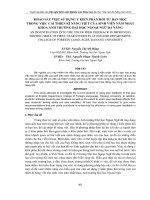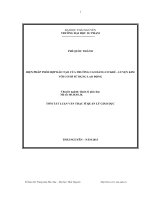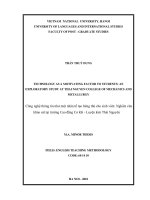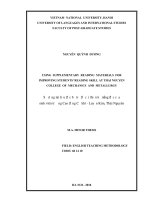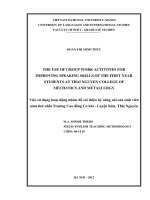- Trang chủ >>
- Đề thi >>
- Đề thi lớp 6
SỬ DỤNG TÀI LIỆU ĐỌC BỔ TRỢ ĐỂ CẢI THIỆN KỸ NĂNG ĐỌC CỦA SINH VIÊN TRƯỜNG CAO ĐẲNG CƠ KHÍ – LUYỆN KIM, THÁI NGUYÊN
Bạn đang xem bản rút gọn của tài liệu. Xem và tải ngay bản đầy đủ của tài liệu tại đây (236.44 KB, 6 trang )
<span class='text_page_counter'>(1)</span><div class='page_container' data-page=1>
<b>USING SUPPLEMENTARY READING MATERIALS </b>
<b>FOR IMPROVING STUDENTS' READING SKILLS </b>
<b>AT COLLEGE OF MECHANICS AND METALLURGY </b>
<b>Nguyen Quynh Duong1, Van Thi Quynh Hoa2 </b>
<i>1</i>
<i>Thai Nguyen University, University of Agriculture and Forestry - TNU </i>
ABSTRACT
The action research aimed at investigating the efficiency of supplementary reading materials in
improving students’ reading skills. The participants of the study were 58 second-year students of
Information Technology Faculty at College of Mechanics and Metallurgy in Thai Nguyen. The
study which lasted for ten weeks used the two tests (pre-test and post-test) and students’
questionnaire as the instrumentation to collect necessary data. Results of the two tests were
computed and analyzed using t-test for correlated means, the students’ questionnaire was analyzed
qualitatively and quantitatively to give the findings. The results of the tests analysis showed that
supplementary reading materials in an extensive reading program actually helped students improve
their reading skills. The questionnaire analysis also gave students’ attitudes towards reading skills
and reading texts in their textbook New Headway Elementary. Further, it evaluated the
effectiveness of students’ reading strategies applied before the extensive reading program.
Additionally, the results showed that students expressed positive opinions about supplementary
reading materials in the extensive reading program. Based on the findings of the study, some
implications for teaching reading skills were suggested and recommendations were made for the
<b>betterment of the students reading skills and further research was also reccomened. </b>
<i><b>Keywords: reading skills, supplementary reading materials (SRM), intensive reading (IR), </b></i>
<i>extensive reading (ER), college of Mechanics and Metallurgy (CMM) </i>
INTRODUCTION*
Reading is an important mental process that
belongs only to human beings. It helps to
open the door into mankind's treasures of
knowledge. Good reading skills can help
readers make great progress in academic
purposes. They also bring people enjoyment
and enrich their life. Undeniably, a person has
to master these essential skills.
In English teaching and learning, reading is
one of the four important major skills.
However, the effectiveness of teaching and
learning reading is still limited in many
schools and colleges.
Regarding English teaching and learning
methodology, there have been a lot of books
and researches done on reading. Some names to
be considered are Nunan, D. (1991, 1999) in the
series about language teaching and learning,
Brown, H.D. (1994), and Anderson, N.J.
(1999), to name but a few. The given authors
*
<i>Tel: 0946 097707, Email: </i>
share an opinion that once appropriate strategies
are applied, intensive and extensive reading will
help improve students' reading skills.
Methodologically, many teachers are
influenced by the Grammar-translation
method. Accordingly, teaching of reading
means introducing vocabulary, grammatical
structures and translating the text into their
mother tongue. Furthermore, the reading
materials are not sufficient, relevant and
interesting enough for students, which leads
to students’ demotivation in learning reading.
In order to explore the efficiency of using
supplementary reading materials in improving
students' reading skills, the authors conducted
an action research at College of Mechanics
and Metallurgy (CMM). With this study, they
wanted not only to enhance the teaching and
learning efficiency of reading skills, but also
to stimulate students' interest in language
learning as well.
SUBJECT AND METHODOLOGY
</div>
<span class='text_page_counter'>(2)</span><div class='page_container' data-page=2>
engineering and metallurgy for the whole
country. It is located in Thai Nguyen - a
northern mountainous province. Accordingly,
the teaching and learning conditions are not
very good. The college does not have
language laboratories for students to learn
foreign languages. Teaching aids are merely
cassettes, textbooks, board, and chalk.
Reference books are very poor in the college
library. In addition, the class size is large of
about 60-70 students. Consequently, English
teaching and learning is limited.
Entering the college, students are at different
levels of English language proficiency. Most
of them studied English; some of them learnt
French, Chinese or Russian at high school.
However, students are not divided into
different groups depending on their levels of
language proficiency, because there has never
been an official examination to classify them.
The action research is conducted with the
voluntary participation of 58 of 65
second-year students. They are all in the same class
CD-CNTT 46 of the Information Technology
Faculty. The numbers of males and females
are relatively equivalent: 30 males and 28
females. All the students are at the ages from
19 to 24, and come from different provinces
in the North and Central of Vietnam.
The study was conducted as a descriptive one
that employed quantitative approach by means
of tests and survey questionnaire delivered to
CMM second-year non-major English students
to assess their English reading proficiency
before and after the Extensive Reading Program
and their attitudes towards supplementary
reading materials.
In this study, the two tests (pre-test and
post-test) are the main means to gather the data.
First, the pre-test is given to the students in
order to classify their English reading
proficiency before carrying out the ERP.
After eight weeks of ERP, the post-test is
delivered to assess students’ improvement in
reading skills.
Questionnaire enables the researchers not
only to gain the necessary quantitative data,
but also to provide students with a chance to
express their attitudes towards their problems.
FINDINGS, RESULTS AND DISCUSSION
<b>Test results </b>
As shown in table 1, there is overall
improvement in the post-test scores in
comparison with those of the pre-test. In the
pre-test 53.4% is BR (bad readers), in the
post-test the number of BR decreases to
36.2%. Meanwhile, 37.9% of the MR
(medium readers) in the pre-test increases up
to 48.3% in the post-test. Especially, number
of GR (good readers) in the post-test (15.5%)
is much more in comparison with the one of
the pre-test (8.6%).
<i><b>Table 1. Tests results of the three groups BR, MR </b></i>
<i>and GR </i>
<b>N = 58 </b> <b>BR </b> <b>MR </b> <b>GR </b>
Pre-test
31 22 5
53.4% 37.9% 8.6%
Post-test
21 28 9
36.2% 48.3% 15.5%
<b>Results of the questionnaires </b>
<i><b>Students’ attitudes towards reading skills </b></i>
<i><b>and reading texts in the textbooks </b></i>
</div>
<span class='text_page_counter'>(3)</span><div class='page_container' data-page=3>
As can be seen in figure 1, the majority (86.2%) of the students agree that reading is important in
English learning. 13.8% of the students consider it normal in terms of importance and none find it
unimportant.
<i><b>Students’ reading strategies before ERP </b></i>
<i><b>Table 2. Students’ orientation before reading </b></i>
<b>N </b>
<b>° </b>
<b>Questions </b>
<b>Never </b>
<b>(%) </b>
<b>Sometimes </b>
<b>(%) </b>
<b>Usually </b>
<b>(%) </b>
7 Before reading, do you often look at the title and pictures of
the text to predict the content of the reading text? 31 37.9 31
8 Before reading, do you read the questions followed to focus on
important information in the text? 43.1 36.2 20.7
9 When reading, do you skim for general ideas then read
carefully?
36.2 39.7 24.1
<i>As shown in the table 2, in question 7, 31% students never look at the title and pictures of the text </i>
<i>to predict the content of the reading text, and 37.9% sometimes do that. In question 8 about the </i>
<i>reading orientation stage through the text questions, the majority of students (43.1%) never read </i>
the text questions to focus on important information in the text before reading, 36.2% students
<i>sometimes do that while only 20.7% usually read questions beforehand. Answering question 9 </i>
<i>about the reading strategies applied, 36.2% students never skim for general ideas, and 39.7% </i>
<i>sometimes do that, there are only 24.1% students skim for general ideas then read carefully. It </i>
means that from the beginning of the reading process they are not well-oriented about the reading
topic as well as the content of the text.
In one word, part 2 of the students’ questionnaire analysis gives the researchers some important
information about their strategies applied in reading comprehension before ERP. Most students
do not use appropriate strategies from the reading orientation procedure as well as when working
with new vocabulary or the whole text. Next, the analysis and discussion of part 3 showed
<i><b>students' perspectives towards ERP in order to see whether students benefit from the ERP. </b></i>
<i>Students’ attitudes towards Extensive Reading Program </i>
Table 3 shows the results of the third part of the questionnaire on the students’ attitudes towards
the ERP.
<i><b>Table 3. Students’ attitudes towards Extensive Reading Program</b></i>
<b>N° </b> <b>Questions </b> <b>Yes (%) </b> <b>No (%) </b>
15 In your opinion, should we use supplementary reading materials to
improve the reading skill?
93.1 6.9
16 Extensive reading makes you more interested in learning English 93.1 6.9
17 Your reading skill is improved after extensive reading 98.3 1.7
18 Your background knowledge is widened owing to extensive reading 94.8 5.2
19 Extensive reading provides you with more new vocabulary and structures. 96.6 3.4
20 Extensive reading outside the class provides you with enjoyment and
friendly environment. You do not get work pressure with extensive reading.
94.8 5.2
</div>
<span class='text_page_counter'>(4)</span><div class='page_container' data-page=4>
widened and 96.6% confirm that ER provides them with more new vocabulary and structures; in
addition, 94.8% students express their enjoyment of having taken part in ERP and 87.9% decide
to keep on reading extensively after ERP.
<i><b>Table 4. Students’ suggestions for good supplementary reading materials </b></i>
<b>Ranking </b> <b>Items </b>
1 <b> Each reading text should have its glossary. </b>
2 Reading texts should be of various types, such as articles, short stories, letters, emails,
<b>advertisements, diaries … </b>
3 <b> Reading texts should be relevant and within the reader’s background knowledge. </b>
4 <b> Exercises should be of various types. </b>
5 <b> Vocabulary should be familiar with students. </b>
6 <b> Reading texts should have suitable length for elementary students. </b>
7 <b> Time should be set for each reading text. </b>
From the numbers above, it can be concluded
that students like ER because they benefit from
it in different dimensions: enjoyment, friendly
reading environment, widening background
knowledge, enriching vocabulary, and
improving reading skills as well.
When being asked about preferred topics for
reading, they have different viewpoints, but
<i>the most preferrable topics are student life, </i>
<i>famous </i> <i>people, </i> <i>love </i> and <i>science </i> <i>& </i>
<i>technology. It may be inferred that those </i>
topics are interesting, related and realistic to
them. The next ones are ranked as followed:
<i>holidays & festivals, sports, exploration & </i>
<i>adventures, environment. The less enjoyed </i>
<i>topics are health, inventions, education, </i>
<i>business & trading and politics. </i>
For good supplementary materials to improve
the reading skill, students give some suggestions
which are ranked as in table 4 followed:
In their opinions, each reading text should
have its glossary, since students can easily
find the meaning of the new words in the text;
and reading texts should be of various types,
such as articles, short stories, letters, emails,
advertisements, diaries, etc so as to get
familiar with different types of texts in the
real life. Moreover, reading texts should be
relevant and within students’ background
knowledge for them to comprehend. Besides,
exercises should be of various types for
students to practice. In addition, reading texts
should have suitable length and difficulty for
elementary students and time should be set
for each reading text.
In short, students do hope to have better
supplementary materials for improving their
reading skills. Apart from topics, text types,
length and level of difficulty of the reading
texts, good supplementary reading materials
should be relevant and within students’
background knowledge with familiar
vocabulary in order to motivate and improve
their reading skills.
CONCLUSIONS AND RECOMMENDATIONS
<b>Conclusions </b>
The study was carried out at CMM with an
attempt to investigate the efficiency of SRM
in improving of reading skills in particular
and English learning in general. The study
was conducted as an action research within a
class of 58 second-year students involved in
an ERP and provided the following findings:
Firstly, it gave students’ perspectives about
reading skills and the reading sections in their
textbook New Headway Elementary. Students
thought that reading was indispensable, but they
were not satisfied with their textbook very much
in terms of content and reading workload.
Secondly, students’ reading strategies
employed before ERP were identified as
inefficient bottom-up reading model.
</div>
<span class='text_page_counter'>(5)</span><div class='page_container' data-page=5>
Last but not least, students provided positive
impressions on ERP. They also suggested
some useful ideas for better supplementary
reading materials.
<b>Recommendations </b>
<i><b>Selecting and adapting SRM </b></i>
Selecting and adapting SRM are very
important since they should be selected with
great care to fit the suggested criteria by
<i>Nuttall (1996, pp.170-179), such as content </i>
<i>suitability, exploitability, and readability, etc. </i>
In the first place, having professional
experience and language knowledge, the
teacher should help students choose suitable
SRM to them in terms of ages, language
proficiency, likes and others, since students
do not know how fluent they are and what the
books are really about.
Furthermore, the teacher should choose the
materials which are accessible to the students.
They should know something about the topics
beforehand to activate background knowledge
in order to comprehend the content. Students
surely cannot understand and be prevented
from progress in reading if they have no idea
about topics.
Teachers in mountainous institutions may
have difficulties in suggesting reading
materials to students, for there are not many
books available. In this case, adapting or
compiling in-house materials is a preferred
option. They can compile the reading texts
with length, language proficiency, likes, ages
and genres appropriate for her students, then
compose various exercises depending on the
taught in class language items. SRM adapted
should include a variety of text types and
tasks to motivate students. Young people
often prefer game-like or imaginative tasks
such as reordering headings, rearranging
pictures, completing tables/diagrams,
gap-filling, role-play, problem-solving, etc.
<i><b>Designing an ERP </b></i>
It is so important to consider how the program
should be introduced. It is strongly believed
that students should be provided with
necessary reading strategies before they
participate in the ERP. Before carrying out
the ERP, the teacher should explain clearly to
students the aims, objectives of the program
and give instructions on how to select SRM.
During the program, students should read
their texts at home and do some tasks (if
required) and write the summaries. The
teacher should check to make sure whether
students really do the reading, but she/he
should not make any correction. A review
should be taken after first few weeks and at
the end of the ERP for evaluation of its
effectiveness and suggestions for the
adjustment.
In providing students with necessary reading
strategies, it can be briefly said that the
teacher should guide the students to read
interactively. The teacher should be a
reader-model for students and instruct them
carefully, clearly in different processes:
orientation (by title, pictures, skimming in
top-down approach), working with text
(guessing new words from contexts, ignoring
redundant words, ect in bottom-up approach,
activating background knowledge and using
grammar to understand the meanings in
interactive reading, etc). When teaching
reading in classes, some activities can be set
for students to be more accessible to the text:
brief discussion about the topics relevant to
the text, providing text-based guided
questions etc.
Especially, teaching reading may be combined
with other skills (speaking, writing, listening).
Seminars or bulletin reports can be the place for
students to show what they gain from their
reading. These activities make students more
active and motivated in reading.
REFERENCES
</div>
<span class='text_page_counter'>(6)</span><div class='page_container' data-page=6>
<i>2. Brown, H.D. (1994). Teaching by principles, an </i>
<i>interactive approach to language pedagogy. San </i>
Francisco: Longman.
<i>3. Nunan, D. (1991). Language teaching </i>
<i>methodology. London: Prentice Hall. </i>
<i>4. Nunan, D. (1999). Second language teaching </i>
<i>and learning. Heinle & Heinle Publishers. </i>
<i>5. Nuttall, C. (1996). Teaching reading skills in a </i>
<i>foreign language (2nd edition). Macmillan </i>
Heinemann.
<i>6. Silberstein, S. (1994). Techniques and </i>
<i>resources in teaching reading. Oxford: Oxford </i>
University Press.
TÓM TẮT
<b>SỬ DỤNG TÀI LIỆU ĐỌC BỔ TRỢ ĐỂ CẢI THIỆN KỸ NĂNG ĐỌC CỦA </b>
<b>SINH VIÊN TRƯỜNG CAO ĐẲNG CƠ KHÍ – LUYỆN KIM, THÁI NGUYÊN </b>
<b>Nguyễn Quỳnh Dương1*<sub>, Văn Thị Quỳnh Hoa</sub>2 </b>
<i>1<sub>Đại học Thái Nguyên, </sub>2<sub>Trường Đại học Nông Lâm – ĐH Thái Nguyên </sub></i>
Nghiên cứu hành động này nhằm mục đích điều tra tính hiệu quả của tài liệu đọc bổ trợ trong việc
nâng cao kỹ năng đọc của sinh viên. Tham gia vào nghiên cứu là 58 sinh viên năm thứ hai Khoa
CNTT của trường Cao đẳng Cơ khí - Luyện kim, Thái Nguyên. Nghiên cứu kéo dài trong mười
tuần, sử dụng bài kiểm tra trước, bài kiểm tra sau khi áp dụng chương trình đọc bổ trợ và bảng câu
hỏi điều tra để thu thập các dữ liệu cần thiết. Kết quả phân tích các bài kiểm tra cho thấy tài liệu
đọc bổ trợ ngồi chương trình đã giúp sinh viên cải thiện kỹ năng đọc của mình. Việc phân tích các
câu trả lời trong bảng hỏi đáp cũng cho biết thái độ của sinh viên đối với kỹ năng đọc và quan điểm của
sinh viên về các bài đọc trong giáo trình. Nghiên cứu cũng đánh giá tính hiệu quả của các chiến lược
đọc mà sinh viên áp dụng trước khi tham gia vào chương trình đọc bổ trợ. Sinh viên đã bày tỏ ý kiến
tích cực và đưa ra các gợi ý về tài liệu cho chương trình đọc thêm. Từ kết quả nghiên cứu, các tác giả
đưa ra một số đề xuất cho việc dạy kỹ năng đọc và gợi ý cho các nghiên cứu sau này.
<i><b>Từ khoá: kỹ năng đọc, tài liệu đọc bổ trợ (SRM), đọc trong chương trình (IR), đọc ngồi chương </b></i>
<i>trình (ER), trường Cao đẳng Cơ khí - Luyện kim (CMM) </i>
<i><b>Ngày nhận bài: 24/8/2016; Ngày phản biện: 20/9/2016; Ngày duyệt đăng: 31/03/2017</b></i>
*
</div>
<!--links-->



